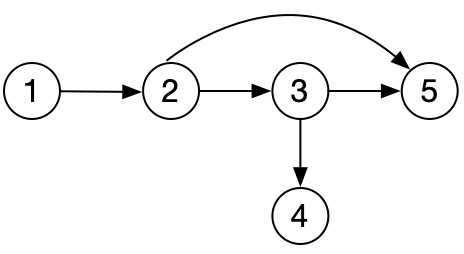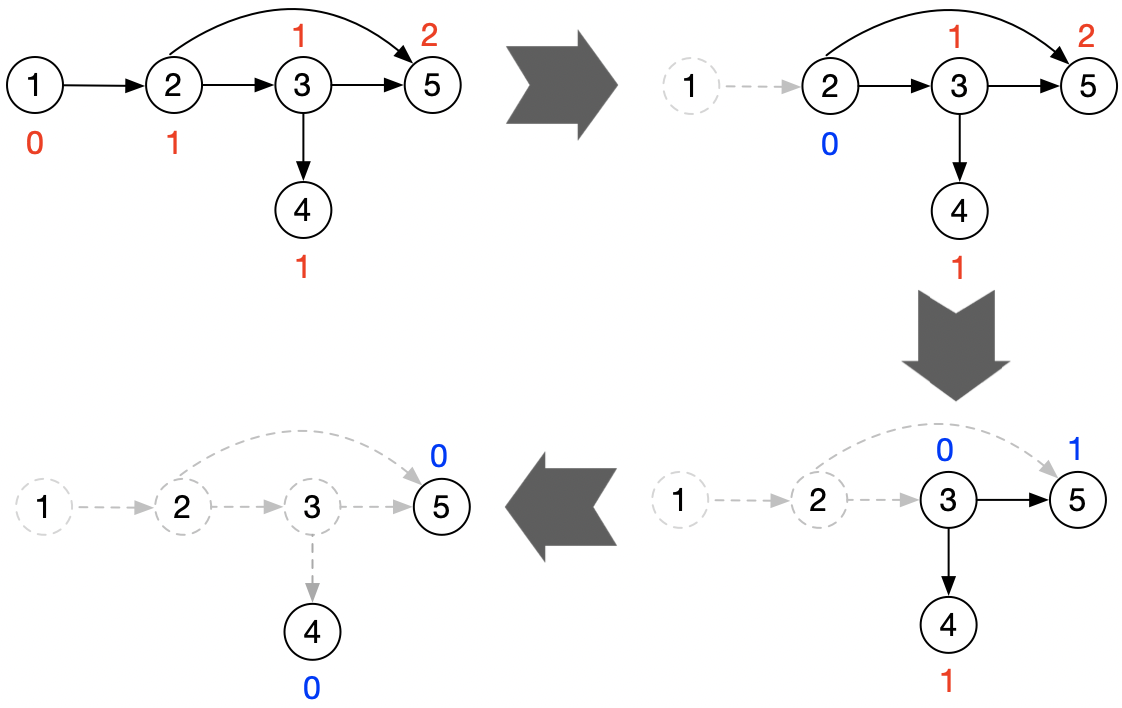算法练习(18)-图的拓扑排序

如上图,假设有一个大型代码工程,里面有5个模块:
模块1依赖模块2
模块2依赖模块3和模块5
模块3依赖模块4和模块5
那么,项目在编译时,应该按怎样的的顺序编译? 这就是所谓的拓扑排序问题
就这个示例而言,显然正确的编译顺序是:5->4->3->2->1 或 4->5->3->2->1 (注:4与5之间没有相互依赖,谁先谁后都可以)
思路:如下图,先找出入度为0的节点,然后以它为源点,依次把相邻节点的入度减1,然后再以下1个入度为0的点做为起点,依次反复,直到最后所有节点的入度都为0,最后把这个过程中经过的入度为0的点,倒过来,就是正确的顺序。

算法并不复杂,但问题在于,如果面试中遇到该题,通常给的输入并非图结构,可能是个二维数据,比如:
int[][] arr = new int[][]{
new int[]{1, 2},
new int[]{2, 5},
new int[]{2, 3},
new int[]{3, 4},
new int[]{3, 5}
};
第1个数字表示自身,第2个数字表示下1个依赖的节点,这种情况,只要转换成上一篇里的Graph结构即可:
Graph convert(int[][] arr) {
List<Node> nodes = new ArrayList<>();
List<Edge> edges = new ArrayList<>();
HashMap<Integer, Node> map = new HashMap<>();
for (int[] items : arr) {
int curVal = items[0];
int nextVal = items[1];
Node cur = map.get(curVal);
Node next = map.get(nextVal);
if (cur == null) {
cur = new Node(curVal);
map.put(curVal, cur);
}
if (next == null) {
next = new Node(nextVal);
map.put(nextVal, next);
}
if (!cur.nexts.contains(next)) {
cur.nexts.add(next);
next.in++;
}
if (!nodes.contains(cur)) {
nodes.add(cur);
}
if (!nodes.contains(next)) {
nodes.add(next);
}
}
Graph g = new Graph(nodes, edges);
return g;
}
注:本算法中,并不需要用到边Edge,所以上面的转换过程,并没有处理Edge.
接下来,就可以开始搞拓扑排序了:
import java.util.ArrayList;
import java.util.HashMap;
import java.util.List;
import java.util.Stack;
public class GraphTest {
Graph convert(int[][] arr) {
List<Node> nodes = new ArrayList<>();
List<Edge> edges = new ArrayList<>();
HashMap<Integer, Node> map = new HashMap<>();
for (int[] items : arr) {
int curVal = items[0];
int nextVal = items[1];
Node cur = map.get(curVal);
Node next = map.get(nextVal);
if (cur == null) {
cur = new Node(curVal);
map.put(curVal, cur);
}
if (next == null) {
next = new Node(nextVal);
map.put(nextVal, next);
}
if (!cur.nexts.contains(next)) {
cur.nexts.add(next);
next.in++;
}
if (!nodes.contains(cur)) {
nodes.add(cur);
}
if (!nodes.contains(next)) {
nodes.add(next);
}
}
Graph g = new Graph(nodes, edges);
return g;
}
/**
* 拓扑排序
*
* @param g 有向无环图
* @return
*/
List<Integer> topologicalSort(Graph g) {
//找出入度为0的节点
Node first = null;
for (Node node : g.nodes) {
if (node.in == 0) {
first = node;
break;
}
}
//相邻节点入度-1, 如减到0,则入栈
Stack<Node> stack = new Stack<>();
stack.add(first);
while (first.nexts.size() != 0) {
for (Node next : first.nexts) {
next.in--;
if (next.in == 0) {
stack.add(next);
first = next;
}
}
}
//弹出结果
List<Integer> list = new ArrayList<>();
while (!stack.isEmpty()) {
list.add(stack.pop().value);
}
return list;
}
public static void main(String[] args) {
GraphTest t = new GraphTest();
int[][] arr = new int[][]{
new int[]{1, 2},
new int[]{2, 5},
new int[]{2, 3},
new int[]{3, 4},
new int[]{3, 5}
};
Graph g = t.convert(arr);
List<Integer> result = t.topologicalSort(g);
System.out.println(result);
}
}
输出:[5, 4, 3, 2, 1]
作者:菩提树下的杨过
出处:http://yjmyzz.cnblogs.com
本文版权归作者和博客园共有,欢迎转载,但未经作者同意必须保留此段声明,且在文章页面明显位置给出原文连接,否则保留追究法律责任的权利。
出处:http://yjmyzz.cnblogs.com
本文版权归作者和博客园共有,欢迎转载,但未经作者同意必须保留此段声明,且在文章页面明显位置给出原文连接,否则保留追究法律责任的权利。



 浙公网安备 33010602011771号
浙公网安备 33010602011771号